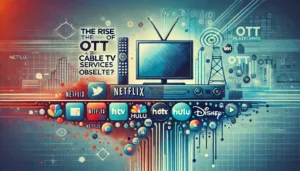 In recent years, Over-the-Top (OTT) platforms have taken the entertainment world by storm. These streaming services deliver content directly to viewers via the Internet, bypassing traditional cable TV providers. With the surge in popularity of OTT platforms such as Netflix, Hulu, and Disney+, many are wondering if cable TV is slowly becoming a thing of the past.
In recent years, Over-the-Top (OTT) platforms have taken the entertainment world by storm. These streaming services deliver content directly to viewers via the Internet, bypassing traditional cable TV providers. With the surge in popularity of OTT platforms such as Netflix, Hulu, and Disney+, many are wondering if cable TV is slowly becoming a thing of the past.
In this article, we’ll explore the rapid growth of OTT services and how they’re challenging traditional cable TV in terms of content, accessibility, and cost-effectiveness.
What Are OTT Platforms?
OTT platforms are services that offer streaming media directly to consumers via the internet, eliminating the need for cable or satellite television subscriptions. These services allow users to watch movies, TV shows, and live events from anywhere, at any time, using a variety of devices like smartphones, tablets, smart TVs, or computers.
Why Are OTT Platforms Gaining Popularity?
OTT platforms have several advantages over traditional cable TV, which explains their increasing popularity:
- On-Demand Viewing: One of the main benefits of OTT platforms is that they allow users to watch content at their convenience. Unlike cable TV, where viewers have to wait for scheduled programming, OTT services offer a vast library of on-demand content.
- Cost-Effective: Cable TV packages can be expensive due to bundled channels, many of which users may not even watch. In contrast, OTT platforms provide flexible subscription options, often at a lower cost. For example, HBO Max offers different pricing tiers based on whether you want an ad-supported or ad-free experience.
- Wide Range of Content: OTT platforms offer a broad range of content, from original series and movies to documentaries and foreign films. OTT services like Amazon Prime Video even include exclusive content that can’t be found anywhere else.
OTT vs. Cable TV: A Comparison
| Feature | OTT Platforms | Cable TV |
|---|---|---|
| Content Access | On-demand, stream anywhere | Scheduled programming, TV-only access |
| Cost | Subscription-based, more affordable | Higher monthly fees, bundled channels |
| Content Variety | Global and niche content available | Regional channels and local programming |
| Device Compatibility | Phones, tablets, smart TVs, more | Limited to television sets |
| Ad Experience | Some platforms offer ad-free plans | Many channels feature ads during shows |
The Decline of Cable TV Subscriptions
According to a 2024 report by eMarketer, the number of traditional cable TV subscribers in the USA has been steadily declining, while OTT platform users continue to rise. More consumers are cutting the cord and opting for streaming services because of their flexibility and content options.
Cable companies like Comcast and Spectrum have seen significant drops in their subscriber base, and many are trying to pivot to OTT offerings to stay relevant. For instance, Comcast launched its own OTT service, Peacock, in 2020, which has since gained a solid user base.
Challenges Faced by OTT Platforms
While OTT platforms are on the rise, they do face some challenges. One of the biggest hurdles is content licensing. Due to different licensing agreements, certain shows or movies might not be available in all regions. This is something that services like Netflix have had to navigate carefully.
Another challenge is bandwidth limitations. Since OTT services rely on internet access, users with slow or inconsistent internet may experience buffering or quality issues. This contrasts with cable TV, where programming is delivered directly through cable connections, ensuring a stable broadcast.
What Does the Future Hold?
The future of entertainment looks to be centered on OTT platforms. With the rise of original content production, better mobile app experiences, and personalized content recommendations, OTT services will likely continue to grow. Services like Apple TV+ and YouTube TV are exploring innovative features to attract more users, such as interactive streaming and live TV integration.
Cable TV may not disappear entirely, but its role will certainly diminish as more consumers embrace OTT platforms for their entertainment needs.
Conclusion
OTT platforms are rapidly reshaping the entertainment industry by offering convenient, affordable, and diverse content options. While cable TV has long been a dominant force in the entertainment world, its future is uncertain in the face of OTT’s unstoppable growth. The ability to stream content whenever and wherever you want makes OTT platforms an appealing alternative to traditional cable services.
So, are cable TV services becoming obsolete? While they may not vanish overnight, the shift towards OTT is undeniable, and the trend is only gaining momentum as more people opt for the convenience and variety offered by these platforms.




